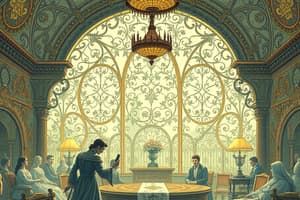Podcast
Questions and Answers
What does Hamlet wish regarding his flesh?
What does Hamlet wish regarding his flesh?
He wishes that it would melt, thaw, and resolve itself into a dew.
What commandment does Hamlet reference when discussing suicide?
What commandment does Hamlet reference when discussing suicide?
Thou shall not kill.
How does Hamlet describe his feelings about the world?
How does Hamlet describe his feelings about the world?
Weary, stale, flat, and unprofitable.
What metaphor does Hamlet use to describe the state of Denmark?
What metaphor does Hamlet use to describe the state of Denmark?
Who does Hamlet compare his father to?
Who does Hamlet compare his father to?
What does Hamlet mean when he says 'Frailty, thy name is woman!'?
What does Hamlet mean when he says 'Frailty, thy name is woman!'?
Which mythological figure does Hamlet compare his mother to when discussing grief?
Which mythological figure does Hamlet compare his mother to when discussing grief?
What does Hamlet conclude about his mother's marriage to Claudius?
What does Hamlet conclude about his mother's marriage to Claudius?
What is Hamlet's reaction to his mother's remarriage?
What is Hamlet's reaction to his mother's remarriage?
What recurring theme is present when Hamlet speaks, 'It is not nor it cannot come to good'?
What recurring theme is present when Hamlet speaks, 'It is not nor it cannot come to good'?
Flashcards are hidden until you start studying
Study Notes
Hamlet's First Soliloquy Summary
- Hamlet expresses a desire for his physical form to dissolve, indicating deep despair and thoughts of suicide, motivated by the distressing events following his father's death and his mother's quick remarriage.
- The phrase "too, too solid flesh" indicates both regret and suicidal ideation, with textual interpretations differing on whether it reflects feelings of being overcome by external forces or feelings of being tainted by familial betrayal.
- The reference to suicide contrasts with religious beliefs, highlighting Hamlet’s inner conflict and foreshadowing ongoing themes of mortality and self-contemplation throughout the play.
Disgust with the World
- Hamlet feels a pervasive weariness towards life, deeming it "weary, stale, flat and unprofitable," reflecting his emotional paralysis and inability to act on avenging his father's murder.
- His contempt for the current state of Denmark is encapsulated in the imagery of an "unweeded garden," symbolizing decay and moral corruption within his surroundings.
Familial Betrayal and Gender Views
- Hamlet compares his late father, a noble figure, to his uncle Claudius, whom he views as a base and immoral character, suggesting a stark contrast within family dynamics.
- His frustration intensifies as he articulates disdain for his mother, Gertrude, who has quickly remarried, embodying societal views of frailty and emotional weakness as female characteristics.
Mythological References and Emotional Comparison
- Hamlet draws a sardonic parallel between his mother’s superficial grieving and Niobe, indicating that he views her tears as insincere given her rapid remarriage.
- He further critiques Gertrude’s actions by comparing her mourning period unfavorably to that of animals, indicating a deep sense of betrayal and denouncing her as morally weak.
Self-Deprecation and Existential Reflection
- Hamlet feels distanced from heroic ideals and laments his own inaction, indicating a profound self-loathing and frustration with his inability to rise above his circumstances.
- The speech captures Hamlet's internal struggle with identity and purpose, contrasting his scholarly nature with the bravado expected of a hero, thereby enhancing his sense of inadequacy.
Themes of Incest and Morality
- The term "incestuous sheets" underscores the moral decay Hamlet associates with Claudius's relationship with Gertrude, reinforcing societal conventions of kinship and propriety.
- Hamlet concludes the soliloquy with a sense of hopelessness, acknowledging the painful nature of his reality while feeling compelled to remain silent about his grievances.
Structure and Flow of the Soliloquy
- The speech ends abruptly, reflecting the tension between Hamlet's introspection and the harsh realities he must confront, illustrating the intertwining of his thoughts and the world around him.
- This intricate structure emphasizes the complexity of Hamlet's emotional state and hints at the broader themes of the play, including inaction, moral ambiguity, and existential dread.
Studying That Suits You
Use AI to generate personalized quizzes and flashcards to suit your learning preferences.




